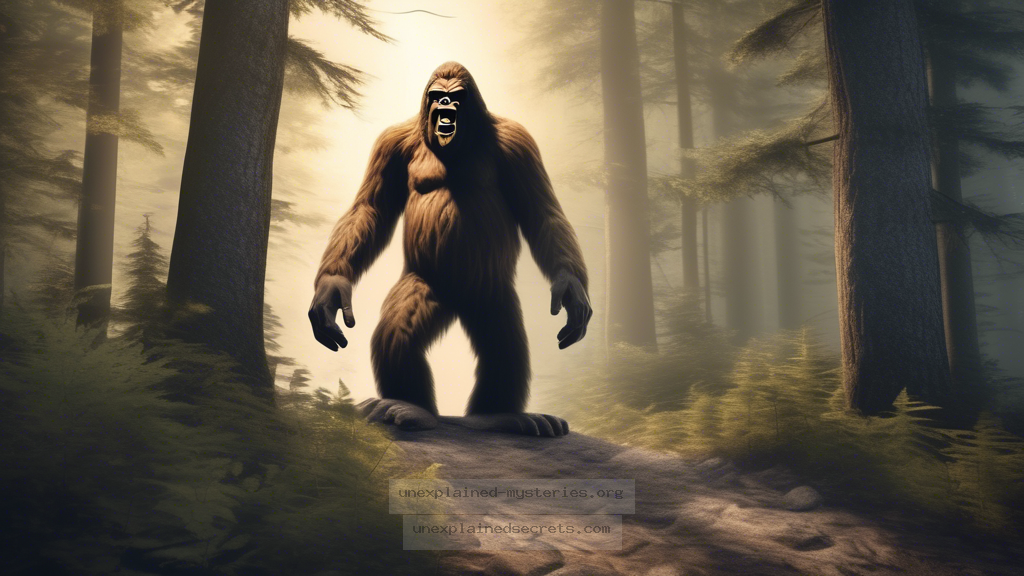What Compelling Evidence Exists for the Existence of Bigfoot in North America?
What Compelling Evidence Exists for the Existence of Bigfoot in North America?
The legend of Bigfoot, also known as Sasquatch, has captivated the imaginations of countless individuals for decades. From blurry photographs to alleged footprints, the search for this elusive creature has generated a plethora of evidence, both compelling and dubious. Understanding the evidence surrounding Bigfoot is crucial, not only for cryptozoologists but also for those interested in the intersection of folklore, biology, and human psychology. This post aims to explore the most significant pieces of evidence supporting the existence of Bigfoot, examining their origins, credibility, and implications for future research.
Historical Context: The Origins of the Bigfoot Legend
The legend of Bigfoot is rooted deeply in Native American folklore, with various tribes across North America recounting tales of large, hairy creatures inhabiting the forests. The term “Sasquatch” itself is derived from the Salish word “sásq’ets,” which means “wild man.” Historical accounts suggest that sightings of such creatures date back to the early 19th century, with reports becoming more prevalent as settlers moved westward and explored unknown territories.
In 1958, the modern fascination with Bigfoot surged when a bulldozer operator named Jerry Crew discovered large footprints in California’s Bluff Creek area. Crew’s discovery led to the first widely publicized investigation of Bigfoot, marking the beginning of organized searches and the establishment of various Bigfoot research organizations. As sightings continued to be reported across the continent, the mythos surrounding Bigfoot grew, leading to a blend of folklore, pseudoscience, and genuine curiosity.
Core Evidence: Footprints and Casts
Perhaps the most iconic evidence of Bigfoot’s existence comes in the form of footprints. Numerous casts have been made over the years, with the most famous being the footprints found in Bluff Creek in 1958. These footprints measured approximately 24 inches long and 8 inches wide, suggesting a creature of significant size.
In 2000, the “Skookum Cast,” created from an alleged Bigfoot sighting in Washington state, purportedly captured the impression of a Bigfoot’s foot along with its leg and buttocks. Researchers analyzed these casts, claiming that the anatomical details were consistent with a creature that would not conform to any known animal in the region.
However, critics argue that many of these footprints could easily be hoaxes created by individuals seeking fame or financial gain. Skeptics often cite the ease with which footprints can be fabricated, leading to a continuing debate on the legitimacy of these casts.
Photographic Evidence: The Patterson-Gimlin Film
One of the most famous pieces of evidence supporting the existence of Bigfoot is the Patterson-Gimlin film, shot in 1967. This short film captures what appears to be a large, bipedal creature walking through the woods of Bluff Creek, California. The film has been subjected to extensive analysis, with some experts claiming that the movement and anatomy of the creature appearing in the film cannot be easily replicated by a human in a suit.
Despite its notoriety, the Patterson-Gimlin film has faced significant scrutiny over the years. Skeptics suggest that it could be a clever hoax or that the creature is simply a man in a costume. However, the ongoing debate over its authenticity continues to fuel interest and research into the existence of Bigfoot.
Audio Evidence: The Sounds of the Forest
In addition to visual evidence, many Bigfoot enthusiasts claim to have recorded vocalizations attributed to the creature. These sounds, often described as howls, whoops, or grunts, have been captured in various locations across North America. One notable example is the “Sierra Sounds,” recorded in the 1970s by Ron Morehead and Al Berry in the Sierra Nevada mountains.
Analysis of these audio recordings has produced mixed results. Some researchers argue that the sounds are indeed consistent with an unknown primate, while others maintain that they resemble recordings of known animals, such as owls, wolves, or even humans. This ambiguity complicates the pursuit of concrete evidence, as the interpretation of audio recordings can often be subjective.
Hair Samples and DNA Analysis
Another line of evidence that has emerged in the quest to prove Bigfoot’s existence involves hair samples purportedly belonging to the creature. In recent years, several samples have been collected and analyzed, with varying results. In 2014, a study published in the journal “Nature” examined hair samples from several North American locations, concluding that many were from known animals, including deer and bears.
However, some researchers claim to have found hair samples that do not match any known species, suggesting the possibility of an undiscovered primate. This raises questions about the genetic diversity of the species and its potential for remaining hidden from modern science. Ongoing DNA analysis attempts to provide clarity on these samples, but the results have yet to conclusively support the existence of Bigfoot.
Practical Implications: The Impact of Belief in Bigfoot
The belief in Bigfoot extends beyond mere curiosity; it has tangible effects on local economies, particularly in regions where sightings are reported. Towns like Willow Creek, California, and Forks, Washington, capitalize on their association with Bigfoot through tourism, merchandise, and events such as Bigfoot festivals. The economic boost from ‘Sasquatch tourism’ illustrates that the legend has a significant cultural and financial impact.
Additionally, the ongoing search for Bigfoot has implications for wildlife conservation and awareness. The interest in protecting habitats where Bigfoot is purported to roam can lead to broader environmental advocacy, emphasizing the importance of preserving natural ecosystems regardless of the creature’s existence.
Alternative Perspectives: Skepticism and Scientific Inquiry
While many enthusiasts are passionate about the search for Bigfoot, there is a substantial body of skepticism within the scientific community. Critics argue that the lack of concrete evidence, coupled with the absence of a body or verified remains, undermines the credibility of claims made by believers. Additionally, they point to the psychological aspects of belief in cryptids, suggesting that the human tendency to fill gaps in knowledge with folklore and myth may play a significant role in the Bigfoot phenomenon.
Scientists advocate for a more rigorous approach to studying alleged sightings and evidence, emphasizing the importance of scientific methodology and skepticism. They encourage the use of advanced technologies, such as wildlife cameras and genetic testing, to gather data that can either support or debunk claims of Bigfoot’s existence.
Common Misconceptions: Myths about Bigfoot
There are numerous misconceptions surrounding Bigfoot that can cloud the investigation into its existence. One common myth is that Bigfoot is merely a figment of human imagination, entirely fabricated by those seeking attention. While it is true that some reports may be hoaxes, the sheer volume of sightings and encounters warrants further investigation.
Another misconception is that Bigfoot is a solitary creature. Many reports suggest that Bigfoot lives in family units, raising the possibility of a breeding population. Understanding the social structure of such a creature could be crucial for its conservation and study.
Best Practices for Investigation and Study
For those interested in investigating Bigfoot sightings or evidence, there are several best practices to consider. First and foremost, approach the subject with an open yet critical mind. Documenting sightings, footprints, and sounds should be done methodically, with a focus on gathering verifiable data.
Utilizing technology is also essential. Employing high-quality cameras, audio recording devices, and even drones can enhance the quality of evidence collected. Collaboration with local wildlife experts and researchers can provide valuable insights and increase credibility.
Future Developments: Ongoing Research and Exploration
As interest in Bigfoot continues to grow, so does the potential for new discoveries. Recent advances in DNA analysis and environmental monitoring technologies may provide new avenues for research. Projects like the “Bigfoot Genome Project” aim to analyze genetic material collected from various regions in North America, potentially uncovering new insights into the creature’s existence.
Moreover, the rise of social media has allowed for a more significant sharing of evidence and experiences, creating a community of enthusiasts and researchers dedicated to unraveling the mystery of Bigfoot. This collaborative spirit may pave the way for future breakthroughs, potentially leading to a more comprehensive understanding of this enigmatic creature.
Conclusion: The Ongoing Quest for Bigfoot
The question of Bigfoot’s existence remains one of the most intriguing mysteries in the realm of cryptozoology. While compelling evidence, such as footprints, audio recordings, and photographic evidence, has emerged over the decades, skepticism and the lack of definitive proof continue to challenge the narrative. As researchers and enthusiasts explore this enigma, it is vital to maintain a balance between curiosity and critical inquiry.
Whether Bigfoot is a hidden species yet to be discovered or simply a product of folklore and human imagination, the quest for answers is an essential part of our exploration of the unknown. The stories of Bigfoot not only reflect humanity’s desire for adventure and wonder but also emphasize our connection to the natural world. As we continue to probe the forests and mountains of North America, the legend of Bigfoot will undoubtedly persist, inviting us to explore the mysteries that lie just beyond the shadows.
Other Articles
Recent Posts
- What Happened to Flight MH370? The Conspiracy Theories That Still Haunt Us
- What Secrets Lurk Within the Walls of the Infamous Trans-Allegheny Lunatic Asylum?
- What Evidence Supports the Existence of Bigfoot in the Pacific Northwest?
- What Happened to the Indus Valley Civilization? Unraveling the Mysteries of Ancient Urban Life
- Can Telepathy Be Scientifically Proven Through Laboratory Evidence?







